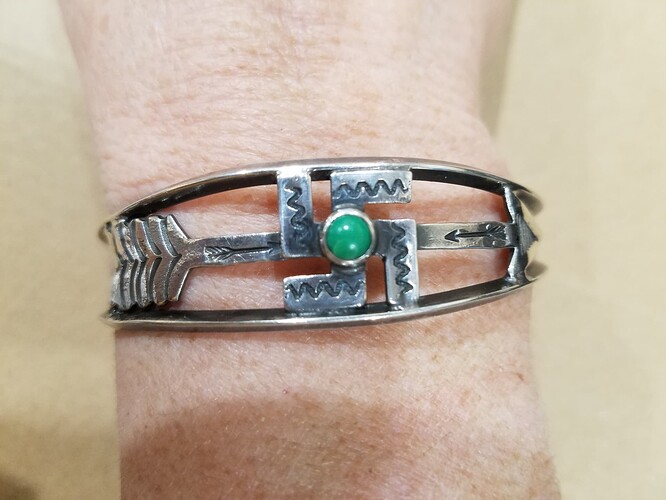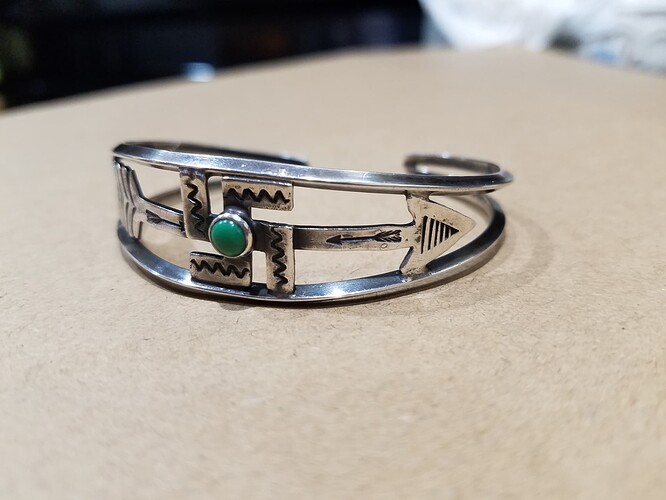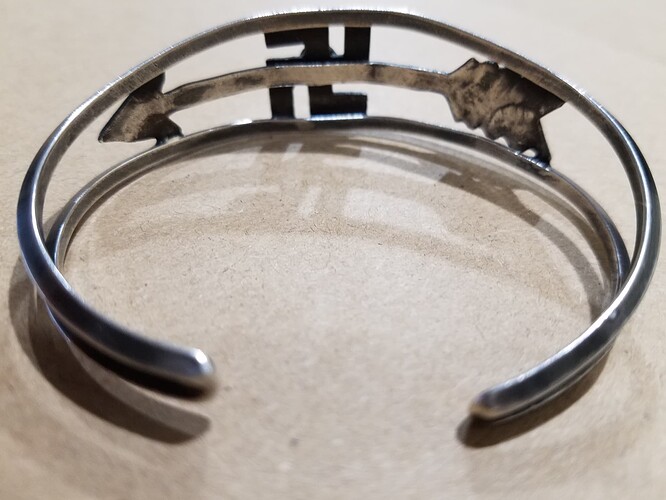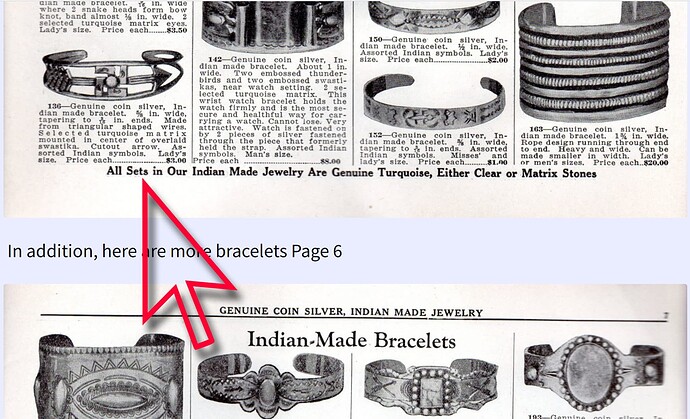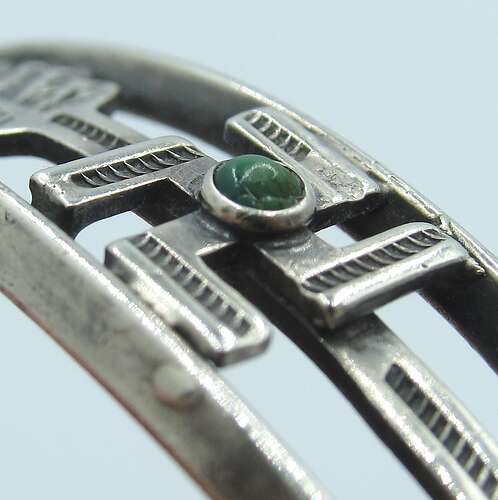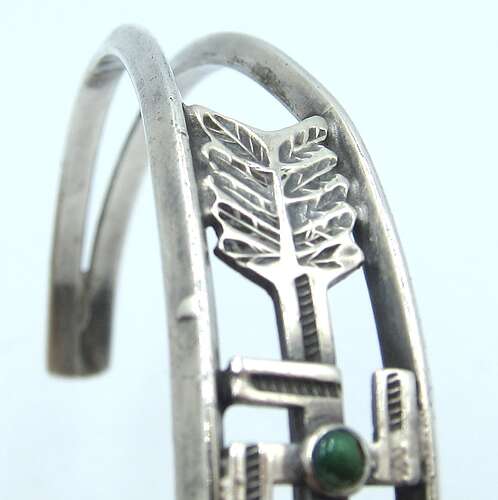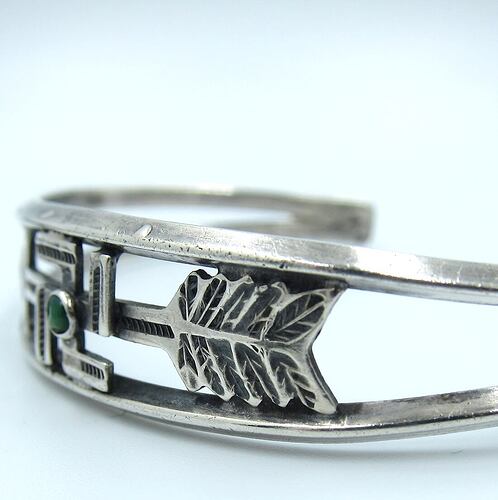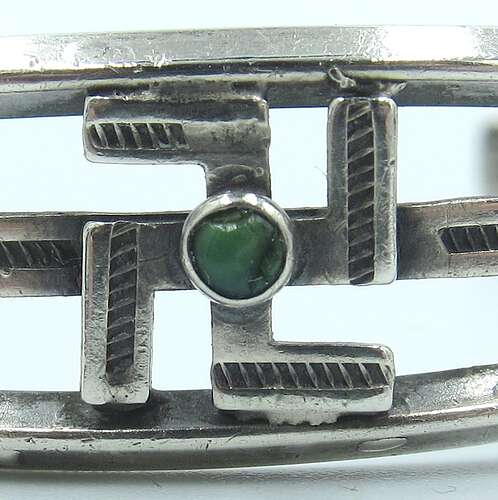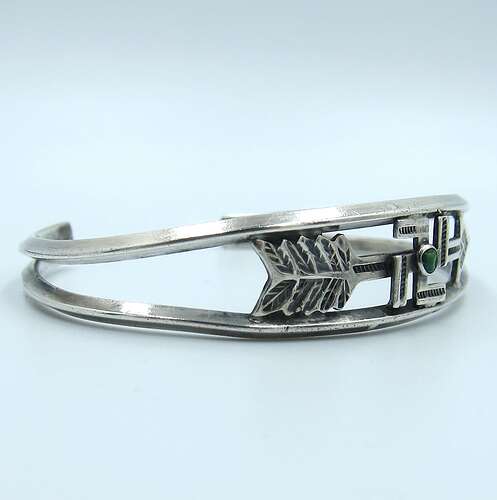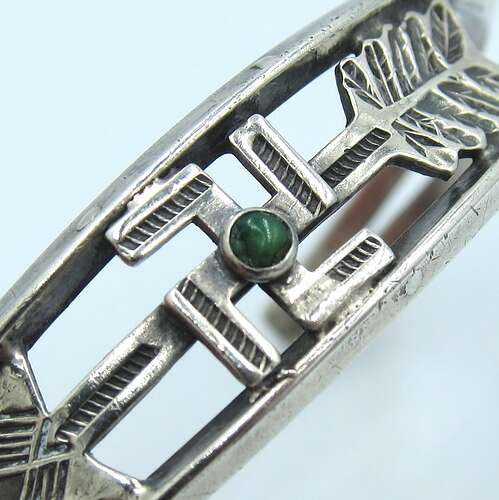A friend of mine has this bracelet and we’ve been debating whether it is truly Fred Harvey era or possibly a reproduction. I don’t own any Fred Harvey pieces so I’m no expert. But because they were tourist pieces, they may not have been the best quality??? If anyone cares to help settle our bet, I’d really appreciate it. An Impossible Burger is on the line here! Lol Thanks everyone!
It is always a little confusing the terminology, I think of this as Fred Harvey era start of 1900s to mid 1900s. I don’t believe it to be a Fred Harvey piece, this work seems a little more complicated than what we think of a Fred Harvey creation. Hope that helps and someone gets that tasty impossible burger.
To me it looks pretty new. Not much wearing on the silver.
Hope you were the one betting on a reproduction. Either way, enjoy the burger!
I say reproduction. This isn’t typical of Harvey style or look. The stamping is too different and too deep, black, and crisp and the cutouts and design elements aren’t of the Harvey look at all. Additionally, the rails are so shiny and new…and again not typical of Harvey pressed sheet metal construction.
Harvey Era is a treasured commodity! To this day it is my number one seller. Your piece looks like you both get a burger to me. Entertain the idea that this could be both. This could be a creation using an older piece of jewelry and repurposing it into a new cuff. It might be worth looking at the old catalogs online and see if you can identify the arrow and whirling logs. I reckon there is a 30% chance this could be a composition. Pay particular attention to the arrows around the whirling logs. Notice how they are not evenly spaced? If this was run through an old stamping machine you will see that offset again.
Thank you all for your input! @Christibo I appreciate your thought of a combo piece as well. I say we both get the impossible burgers but I get fries with mine! Lol
Coincidentallu, I just found an Ebay listing with a similar bracelet. Same style, different stamping. Maybe this would lend further clues???
Where do you sell your FH jewelry? Do you have a link to your shop? I have a few FH cuffs I would like to find the value of. Thanks.
If you click on Christibo profile pic it takes you to his profile and a link to his shop is included.
I’d call this an homage (?) piece, rather than a reproduction. The factory triangle wire shank isn’t Harvey era, and I’m 99% that the arrow whirling log/arrow centerpiece soldered on to the triangle wire shank is a casting.
That’s interesting. The second bracelet posted looks to be hand fabricated from milled sheet and wire, and may genuinely have some real age to it. I’m sticking with my assessment of bracelet #1. I don’t believe that one is Harvey era.
testing the metal for coin silver or sterling might settle the burger bet.
found another with excellent photos I’ll archive here.
This one too looks (more) hand made.
Some things to keep in mind when assessing authenticity with regard to a particular manufacturer, maker, or era are:
If a design is present in a widely distributed catalog or other publication, there are usually plenty of copies floating around. If it’s a popular design, a “hot seller” so to speak, there are usually a lot of copies.
While very early Navajo Jewelry was actually made from silver coins, sheet silver has been around for a very long time, and can be milled to purpose in a desired alloy. “Coin” silver is related to actual silver content in an alloy (usually 80% -90%). Its use over sterling in a production, or “homework” setting is likely related to keeping the producers cost as low as possible. For a manufacturer, requiring the silversmith to create raw materials by beating coins into sheet on an anvil, and making wire through draw plates exponentially increases the amount time necessary to make a piece of jewelry, and potentially adds exponentially to the labor cost. When producing for a catalog, or anything in quantity really, a manufacturer or individual producer will almost alway use the most efficient lowest cost option possible.
Casting has been around a lot longer than just about any other process for efficiently reproducing almost any given design or item with a high degree of consistency and fidelity at a low relative unit cost (on the cheap). Almost anytime casting can be employed to lower the unit cost of producing a copy, it will be used. As with sheet silver, alloys used in casting can vary widely, and an item testing as coin or alternatively sterling does not necessarily mean a cast item came from a particular era.
In the absence of a documented paper trail or verified hallmark, the best any of us can do is offer an educated guess. For what its worth, some guesses are more educated than others, but it’s always still a guess.
Hello
I noticed some pretty FH cuffs with Dragons Breath and others with Dichrotic glass labeled dragons breath. Are they pretty much the same?? Thanks
